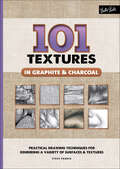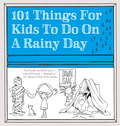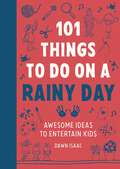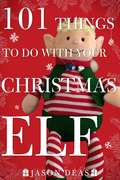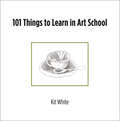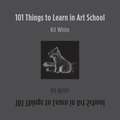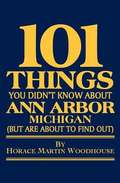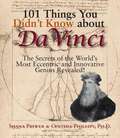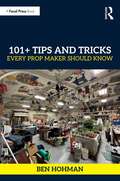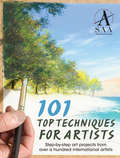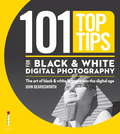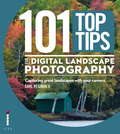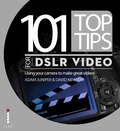- Table View
- List View
101 Textures in Graphite & Charcoal: Practical Drawing Techniques for Rendering a Variety of Surfaces & Textures
by Steven Pearce101 Textures in Graphite & Charcoal is a must-have resource for all graphite and charcoal artists. This guide provides step-by-step instructions on drawing key textures you'd find in any illustration. Accurately rendering surfaces and textures is one of the most challenging aspects of working with graphite pencil and charcoal. 101 Textures in Graphite & Charcoal provides artists with step-by-step instructions for learning how to draw a wide variety of the most common textures and surfaces, including sand, water, metals, foliage, wood, fabrics, stone, grass, hair, and many more. Opening with a general introduction to basic drawing tools, materials, and drawing techniques, each page in this comprehensive resource features two to three easy-to-follow steps demonstrating how to create each specific texture. You will will discover tips and techniques for working in both graphite and charcoal and how to manage their differences when hatching, stippling, scumbling, blending, and more. With its breadth of coverage, easy-to-follow instruction, and helpful tips, 101 Textures in Graphite & Charcoal is a must-have resource for artists of all skill levels.
101 Things for Kids to do on a Rainy Day
by Dawn IsaacFrom the author of 101 Things for Kids to do Outside, which has fast become a go-to book for children and parents alike, comes this excellent new volume full of creative (and occasionally crazy) ideas for things to do when the weather is bad and you're stuck inside - without having to go any where near a TV or computer screen! Why not grow a windowsill herb garden, make your own jigsaw, or learn to play the glasses? Get crafty with decoupage and salt dough, or play detective by dusting for fingerprints. Exciting makes include terrariums and kaleidoscopes, whilst wacky games cover everything from Balloon Stomp to Sticky Note Scramble. All 101 ideas are designed to be achievable with little or no parental help, and only use materials that you already have around the house. With a wealth of creative and fun suggestions to keep you amused, you might not even notice that the rain has stopped.
101 Things for Kids to do on a Rainy Day
by Dawn IsaacFrom the author of 101 Things for Kids to do Outside, which has fast become a go-to book for children and parents alike, comes this excellent new volume full of creative (and occasionally crazy) ideas for things to do when the weather is bad and you're stuck inside - without having to go any where near a TV or computer screen! Why not grow a windowsill herb garden, make your own jigsaw, or learn to play the glasses? Get crafty with decoupage and salt dough, or play detective by dusting for fingerprints. Exciting makes include terrariums and kaleidoscopes, whilst wacky games cover everything from Balloon Stomp to Sticky Note Scramble. All 101 ideas are designed to be achievable with little or no parental help, and only use materials that you already have around the house. With a wealth of creative and fun suggestions to keep you amused, you might not even notice that the rain has stopped.
101 Things I Learned® in Advertising School (101 Things I Learned)
by Matthew Frederick Tracy ArringtonProviding unique, accessible lessons on advertising, this title in the bestselling 101 Things I Learned® series is a perfect resource for students, recent graduates, general readers, and even seasoned professionals. The advertising industry is fast paced and confusing, and so is advertising school. This installment in the 101 Things I Learned® series is for the student lost in a sea of jargon, data, and creative dead-ends. One hundred and one illustrated lessons offer thoughtful, entertaining insights into consumer psychology, media, audience targeting, creativity, and design, illuminating a range of provocative questions: Why is half of advertising bound to fail? Why should a mug in an ad be displayed with its handle to the right? How did the ban on cigarette advertising create more smokers? Why do people fall for propaganda? When doesn’t sex sell? Written by an experienced advertising executive and instructor, 101 Things I Learned® in Advertising School is sure to appeal to students, to seasoned professionals seeking new ways to craft an ad campaign, and to small-business owners looking to increase awareness of their brand.
101 Things I Learned In Architecture School
by Matthew Frederick2008 Silver Award Winner, Architecture Category, Independent Publisher Book Awards. and Winning entry, General Trade Illustrated Category, in the 2008 New England Book Show sponsored by Bookbuilders of Boston. This is a book that students of architecture will want to keep in the studio and in their backpacks. It is also a book they may want to keep out of view of their professors, for it expresses in clear and simple language things that tend to be murky and abstruse in the classroom. These 101 concise lessons in design, drawing, the creative process, and presentation--from the basics of "How to Draw a Line" to the complexities of color theory--provide a much-needed primer in architectural literacy, making concrete what too often is left nebulous or open-ended in the architecture curriculum. Each lesson utilizes a two-page format, with a brief explanation and an illustration that can range from diagrammatic to whimsical. The lesson on "How to Draw a Line" is illustrated by examples of good and bad lines; a lesson on the dangers of awkward floor level changes shows the television actor Dick Van Dyke in the midst of a pratfall; a discussion of the proportional differences between traditional and modern buildings features a drawing of a building split neatly in half between the two. Written by an architect and instructor who remembers well the fog of his own student days, 101 Things I Learned in Architecture Schoolprovides valuable guideposts for navigating the design studio and other classes in the architecture curriculum. Architecture graduates--from young designers to experienced practitioners--will turn to the book as well, for inspiration and a guide back to basics when solving a complex design problem.
101 Things I Learned in Architecture School
by Matthew FrederickConcise lessons in design, drawing, the creative process, and presentation, from the basics of “How to Draw a Line” to the complexities of color theory.This is a book that students of architecture will want to keep in the studio and in their backpacks. It is also a book they may want to keep out of view of their professors, for it expresses in clear and simple language things that tend to be murky and abstruse in the classroom. These 101 concise lessons in design, drawing, the creative process, and presentation—from the basics of "How to Draw a Line" to the complexities of color theory—provide a much-needed primer in architectural literacy, making concrete what too often is left nebulous or open-ended in the architecture curriculum. Each lesson utilizes a two-page format, with a brief explanation and an illustration that can range from diagrammatic to whimsical. The lesson on "How to Draw a Line" is illustrated by examples of good and bad lines; a lesson on the dangers of awkward floor level changes shows the television actor Dick Van Dyke in the midst of a pratfall; a discussion of the proportional differences between traditional and modern buildings features a drawing of a building split neatly in half between the two. Written by an architect and instructor who remembers well the fog of his own student days, 101 Things I Learned in Architecture School provides valuable guideposts for navigating the design studio and other classes in the architecture curriculum. Architecture graduates—from young designers to experienced practitioners—will turn to the book as well, for inspiration and a guide back to basics when solving a complex design problem.
101 Things I Learned® in Fashion School (101 Things I Learned)
by Alfredo Cabrera Matthew FrederickA guide to surviving and thriving in fashion school, from an award-winning fashion designer and illustratorSuccess in fashion school requires more than a passion for fashion. It calls for the student to understand the cultural forces that shape what we wear and why we wear it; to develop a wide range of practical, aesthetic, and intellectual skills; and to work hands-on. This accessible guide assists the aspiring fashion designer on this journey with unique illustrated lessons on such topics as:• how to identify the target customer, set priorities, select fabrics, and integrate details• how to measure the human form, cut fabric, and pivot a dart• why you haven&’t designed a garment if you don&’t know how it will be made• how the nuclear bomb dropped on Hiroshima reshaped our understanding of fashion• illustration fundamentals, including proportions, poses, lighting, and rendering• practical information on the industry, including key terms, who does what in the industry, and the workings of the fashion calendarWritten by an experienced fashion designer, illustrator, and instructor, 101 Things I Learned® in Fashion School is an essential resource for beginning fashion students, recent graduates, experienced professionals, and anyone looking for a deeper understanding of how and why the clothes we wear—or choose not to wear—are designed and made.
101 Things I Learned® in Film School (101 Things I Learned)
by Matthew Frederick Neil LandauAn illustrated, accessible introduction to filmmaking from an award-winning Hollywood producer, screenwriter, film school professor, and script consultant to major movie studiosAnyone with a cellphone can shoot video, but creating a memorable feature-length film requires knowledge and mastery of a wide range of skills, including screenwriting, storytelling, directing, visual composition, and production logistics. This book points the aspiring filmmaker down this complex learning path with such critical lessons as:• how to structure a story and pitch it to a studio• ways to reveal a story&’s unseen aspects, such as backstory and character psychology• the difference between plot, story, and theme• why some films drag in Act 2, and what to do about it• how to visually compose a frame to best tell a story• how to manage finances, schedules, and the practical demands of productionWritten by an award-winning producer, screenwriter, film school professor, and script consultant to major movie studios, 101 Things I Learned® in Film School is an indispensable resource for students, screenwriters, filmmakers, animators, and anyone else interested in the moviemaking profession.
101 Things I Learned® in Product Design School (101 Things I Learned)
by Matthew Frederick Sung Jang Martin ThalerAn engaging, enlightening, and cleverly illustrated guide to product design, written by experienced professional designers and instructors. Products are in every area of our lives, but just what product designers do and how they think is a mystery to most. Product design is not art, engineering, or craft, even as it calls for skills and understandings in each of these areas—along with psychology, history, cultural anthropology, physics, ergonomics, materials technology, marketing, and manufacturing. This accessible guide provides an entry point into this vast field through 101 brief, illustrated lessons exploring such areas as • why all design is performed in relation to the body • why every product is part of a system • the difference between being clever and being gimmicky • why notions of beauty are universal across cultures • how to use both storytelling and argument to effectively persuade Written by three experienced design instructors and professionals, 101 Things I Learned® in Product Design School provides concise, thoughtful touch points for beginning design students, experienced professionals, and anyone else wishing to better understand this complex field that shapes our lives every day.
101 Things I Learned® in Urban Design School (101 Things I Learned)
by Matthew Frederick Vikas MehtaProviding unique, accessible lessons on urban design, this title in the bestselling 101 Things I Learned® series is a perfect resource for students, recent graduates, general readers, and even seasoned professionals. Students of urban design often find themselves lost between books that are either highly academic or overly formulaic, leaving them with few tangible tools to use in their design projects. 101 Things I Learned® in Urban Design School fills this void with provocative, practical lessons on urban space, street types, pedestrian experience, managing the design process, the psychological, social, cultural, and economic ramifications of physical design decisions, and more. Written by two experienced practitioners and instructors, this informative book will appeal not only to students, but to seasoned professionals, planners, city administrators, and ordinary citizens who wish to better understand their built world.
101 Things to do on a Rainy Day
by Dawn Isaac'I'm bored' must be the most frightening words in a child's vocabulary, and how to keep kids entertained is something that keeps many of us awake at night. 101 Things to do on a Rainy Day is a brilliant collection of creative (and occasionally crazy) games, activities and projects to do when you're stuck indoors - without having to go anywhere near a TV or computer screen!Why not grow a windowsill herb garden, make your own jigsaw, or learn to play the glasses? Get crafty with decoupage and salt dough, or play detective by dusting for fingerprints. Exciting makes include terrariums and kaleidoscopes, whilst wacky games cover everything from Balloon Stomp to Sticky Note Scramble. All 101 ideas only require materials that you'll already have around the house. With a wealth of ingenious and fun suggestions to keep you amused, you might not even notice that the rain has stopped.The activities are written with children aged 5+ years in mind but it's your call as to how much help, support and age-appropriate supervision they might need ... make whatever adjustments are necessary.
101 Things to do on a Rainy Day
by Dawn Isaac'I'm bored' must be the most frightening words in a child's vocabulary, and how to keep kids entertained is something that keeps many of us awake at night. 101 Things to do on a Rainy Day is a brilliant collection of creative (and occasionally crazy) games, activities and projects to do when you're stuck indoors - without having to go anywhere near a TV or computer screen!Why not grow a windowsill herb garden, make your own jigsaw, or learn to play the glasses? Get crafty with decoupage and salt dough, or play detective by dusting for fingerprints. Exciting makes include terrariums and kaleidoscopes, whilst wacky games cover everything from Balloon Stomp to Sticky Note Scramble. All 101 ideas only require materials that you'll already have around the house. With a wealth of ingenious and fun suggestions to keep you amused, you might not even notice that the rain has stopped.The activities are written with children aged 5+ years in mind but it's your call as to how much help, support and age-appropriate supervision they might need ... make whatever adjustments are necessary.
101 Things to Do with Your Christmas Elf
by Jason DeasChristmas is a magical time of the year. How often have you lain in bed, visions of sugar plums dancing through your head? Maybe you’ve began to gently drift into a dream when, suddenly, you realize . . . you didn’t move the elf!That darn elf. Making you get out of bed when you’re all snuggled up after a long day of gift-wrapping. But you know that if you don’t move it, the kids will begin to unravel the Christmas secrets you’ve worked so hard to preserve over the years! Before you know it, they’ll think Santa isn’t real and they’ll be all grown up. Fine, you say to yourself, I’ll get up and move the freakin’ elf. However, as time goes on, your kids start to notice the elf’s moving to the same spots over and over, doing the same old things. It starts to become less believable.For when you’re stuck in this predicament, author Jason Deas has developed 101 different ideas of what to do with your Christmas elf. Get St. Nick’s assistants off the shelf and into a variety of creative situations that will amaze and amuse your children:Make your elf some skis for water skiing and snow skiingSet up your elf like he’s been working out all night longPut your elf in a boat in the bathtubCreate a drum set with a few cans, pots, plastic containers, and other odds and endsHave your elf become a mechanic and fix a toy carFilled with Christmas spirit and humor, 101 Things To Do With Your Christmas Elf is your handbook to surviving December and making sure you keep your little holiday helper on the move.
101 Things to Learn in Art School
by Kit WhiteLessons, demonstrations, definitions, and tips on what to expect in art school, what it means to make art, and how to think like an artist.What is the first thing to learn in art school? “Art can be anything.” The second thing? “Learn to draw.” With 101 Things to Learn in Art School, artist and teacher Kit White delivers and develops such lessons, striking an instructive balance between technical advice and sage concepts. These 101 maxims, meditations, and demonstrations offer both a toolkit of ideas for the art student and a set of guiding principles for the artist. Complementing each of the 101 succinct texts is an equally expressive drawing by the artist, often based on a historical or contemporary work of art, offering a visual correlative to the written thought. “Art can be anything” is illustrated by a drawing of Duchamp's famous urinal; a description of chiaroscuro art is illuminated by an image “after Caravaggio”; a lesson on time and media is accompanied by a view of a Jenny Holzer projection; advice about surviving a critique gains resonance from Piero della Francesca's arrow-pierced Saint Sebastian.101 Things to Learn in Art School offers advice about the issues artists confront across all artistic media, but this is no simple handbook to making art. It is a guide to understanding art as a description of the world we live in, and it is a guide to using art as a medium for thought. And so this book belongs on the reading list of art students, art teachers, and artists, but it also belongs in the library of everyone who cares about art as a way of understanding life.
101 Things to Learn in Art School
by Kit WhiteArtist and teacher White delivers and develops art school lessons, striking an instructive balance between technical advice and sage concepts. These 101 maxims, meditations, and demonstrations offer both a toolkit of ideas for the art student and a set of guiding principles for the artist.
101 Things You Didn't Know About Ann Arbor, Michigan (But Are About To Find Out)
by Horace WoodhouseAfter you've browsed through this little book, you will better understand why Ann Arbor has a greater quirk quotient than most places. To prove his point, your curious author has dug up bits of esoterica - odd, amusing, and little-known strands that make up the city's variegated fabric. Sure, you live here, but how much do you really know about Ann Arbor? Can you name your hometown football legends, Playboy Magazine playmates, 1960s radicals, NASA astronauts, the local boxer who fought Jack Dempsey, the brainy UM graduate who attempted the perfect crime, or the local girl who flirted with Humphrey Bogart in "The Big Sleep"? Who was the native industrialist who helped build the Panama Canal? Or the Ann Arborite who created the world's largest technology company? How did a border dispute lead to the greatest rivalry in college football? Where is the city's only Frank Lloyd Wright-designed house? What is Ann Arbor's connection a Presidential assassination? Readers learn the answers to these intriguing questions and much, much more. Fascinating tangents and tidbits in purposely random sequence (with generous cross-references) create a ready-to-explore trail of knowledge about Ann Arbor and its environs, informing and entertaining, correcting myths and misconceptions, mostly revealing an unexpected treasure trove that brings a culture and a place into sharp focus.
101 Things You Didn't Know About Da Vinci: The Secrets of the World's Most Eccentric and Innovative Genius Revealed!
by Shana PriwerThanks to the international bestseller The Da Vinci Code, people are more fascinated with Leonardo Da Vinci than ever. This multitalented man--arguably the greatest genius of all time--was not only a magnificent artist, scientist, and inventor, but also a politically minded radical who defied convention and participated in secret societies. This engaging, entertaining book reveals all the secrets about this wildly gifted man, from his prescient inventions and his lost art to his animal rights activism and his sexual preferences--not to mention his enemies and allies in the dark, turbulent world of his time. Readers learn everything they didn't know about the quintessential Renaissance Man the easy way, thanks to the engaging style of 101 Things You Didn't Know about Da Vinci.
101+ Tips and Tricks Every Prop Maker Should Know
by Ben HohmanIn 101+ Tips and Tricks Every Prop Maker Should Know, Utah Shakespeare Festival’s Properties Director Ben Hohman explains tricks of the trade generally not taught in schools, but essential for prop makers working on the job. With tips and tricks divided into subject categories like carpentry, prop math, soft goods, upholstery, finishing, crafts and effects, and tools, the book breaks this knowledge down so that makers and prop managers can easily access the information, learn the skills, and be better prepared and more useful to any shop they work in. Each tip or trick is clearly introduced, features a relevant example of how it is useful, and includes step-by-step instructions. The book also features interviews and tips from prop makers across the creative industries, showcasing different techniques and need-to-know skills, and a glossary of prop terms that will help readers navigate the day-to-day of the prop shop.This book is written for theatrical prop artisans, prop managers, technical theatre students, and anyone who has an interest in prop building or backstage theatrical knowledge. Whether they are novice prop builders or seasoned professionals with decades of experience, this book will provide readers with a wealth of practical information that will serve them in their craft for many years to come.
101 Top Techniques for Artists
by Saa101 Top Techniques for Artists is a colourful compendium packed full of practical tips and techniques by 101 of today's most popular leading artists. Each technique is presented in clear, simple step-by-step instructions that describe how to complete the project yourself, including a full list of materials and detailed images to guide you along the way.Divided into seven chapters that cover watercolours, acrylics, oils, pastels, drawing and mixed media, this handy book is bursting with some of the most popular styles and subjects, designed to showcase the very best of artistic abilities available to help develop your own creative streak.All contributors featured in this book are professional artists belonging to the SAA, who together with a global community of over 46,000 other members, make up the world's largest and friendliest art society. Whether you're a beginner, an improver or a professional, there's something new to learn for everyone in this comprehensive collection.
101 top tips for black & white digital photography: The Art Of Black And White Brought Into The Digital Age
by John BeardsworthJohn Beardsworth breaks the art of black and white photography down into easily-understood and quickly applied tips and tricks that photographers at any level will find useful.
101 Top Tips for Black & White Digital Photography: The Art of Black & White Brought into the Digital Age
by John BeardsworthA comprehensive look at black & white photography by one of today's leading experts on digital-editing software and black & white conversion techniques.John Beardsworth explores the most powerful software for converting your color shots into stunning, high-quality black-and-white photos, with detailed explanations of how each tool works and why to try it out on your own images. His streamlined methods will optimise your workflow and inspire your photography.In addition to providing an abundance of step-by-step instructions with brilliant imagery, Beardsworth also teaches the aesthetic value of black and white, and how to visualise the creative potential of each shot. With its fun and approachable tips-based structure, this book will motivate you to experiment with impressive effects and innovative tools, ensuring that you make full use of the B&W software at your disposal.
101 Top Tips for Digital Landscape Photography: Capturing Great Landscapes With Your Camera (101 Top Tips Ser.)
by Carl Heilman IIThe popularity of specialist periodicals testifies to the fact that landscape photography is perhaps the single most popular genre among hobbyist DSLR owners. In this title, experienced professional landscape photographer Carl Heilman II gives the benefit of a lifetime spent shooting spectacular wilderness and mountain shots, offering a host of easy-to-digest tips and tricks that will allow photographers of all abilities to lift their landscape work to the next level. The reader will learn how to harness natural drama, use difficult lighting situations to your advantage and capture unusual perspectives, all the while benefiting from Carl's clear instruction and beautiful landscape work.
101 Top Tips for Digital Landscape Photography: Capturing Great Landscapes With Your Camera (101 Top Tips Ser.)
by Carl Heilman IIA comprehensive guide to improving your landscape photography by one of today's foremost landscape photographers.Landscape photography is perhaps the single most popular genre among DSLR owners. In 101 Top Tips for Digital Landscape Photography, experienced professional landscape guru Carl Heilman II gives the benefit of a lifetime spent shooting spectacular wilderness and mountain shots, offering a host of targeted tips and tricks that will allow photographers of all abilities to lift their landscape work to the next level.The reader will learn how to harness natural drama, use difficult lighting situations to your advantage and capture unusual perspectives, all the while benefiting from Carl's clear instruction and beautiful landscape work.
101 Top Tips for DSLR Video: Using Your Camera To Make Great Movies
by David Newton Adam JuniperFollowing the arrival of game-changing new cameras from Nikon and Canon, the hottest area in the world of photography has been combining high-definition video capability with all the advantages of SLR's interchangeable lenses. For the first time, full cinematic creativity is within anyone's grasp.With its tips-based structure, this book can be dipped into for reference for movie-makers of any background, or read cover to cover for a complete course in movie-making. With four case studies from real-world professional projects, including a TV advertisement and a music video, 101 Top Tips for DSLR Video provides invaluable guidance for any budding filmmakers.Top Tips for DSLR Video also includes four case studies from real-world professional projects, including a TV advertisement and a music video. Taking you all the way from understanding and choosing the technology, to planning, shooting, editing, and finally publishing your movie, this book contains everything you really need to know about making video with your digital SLR camera.
101 Top Tips for DSLR Video
by David Newton Adam JuniperAll the information a photographer or film-maker needs to create cinema-quality movies with their digital SLR.
